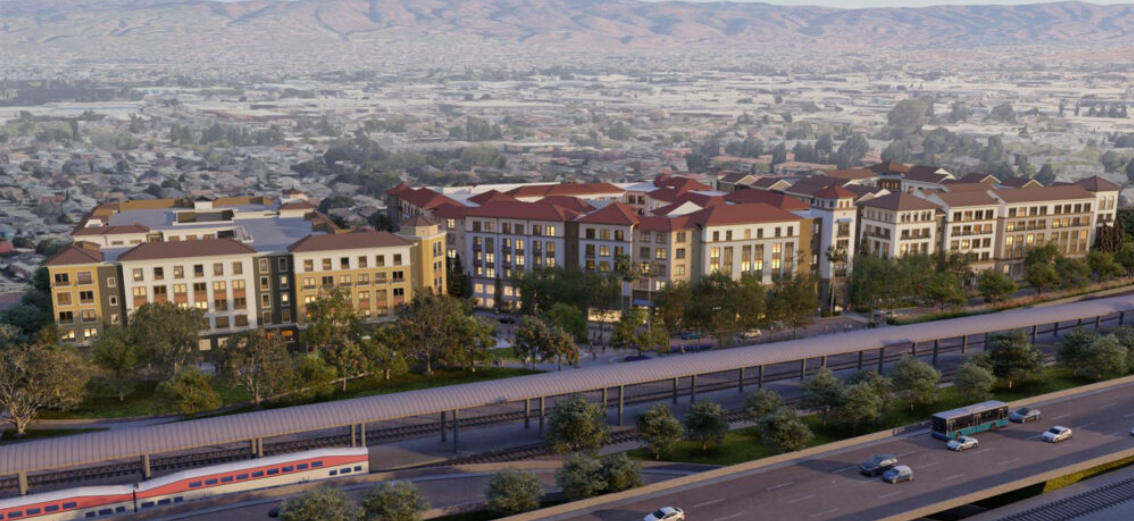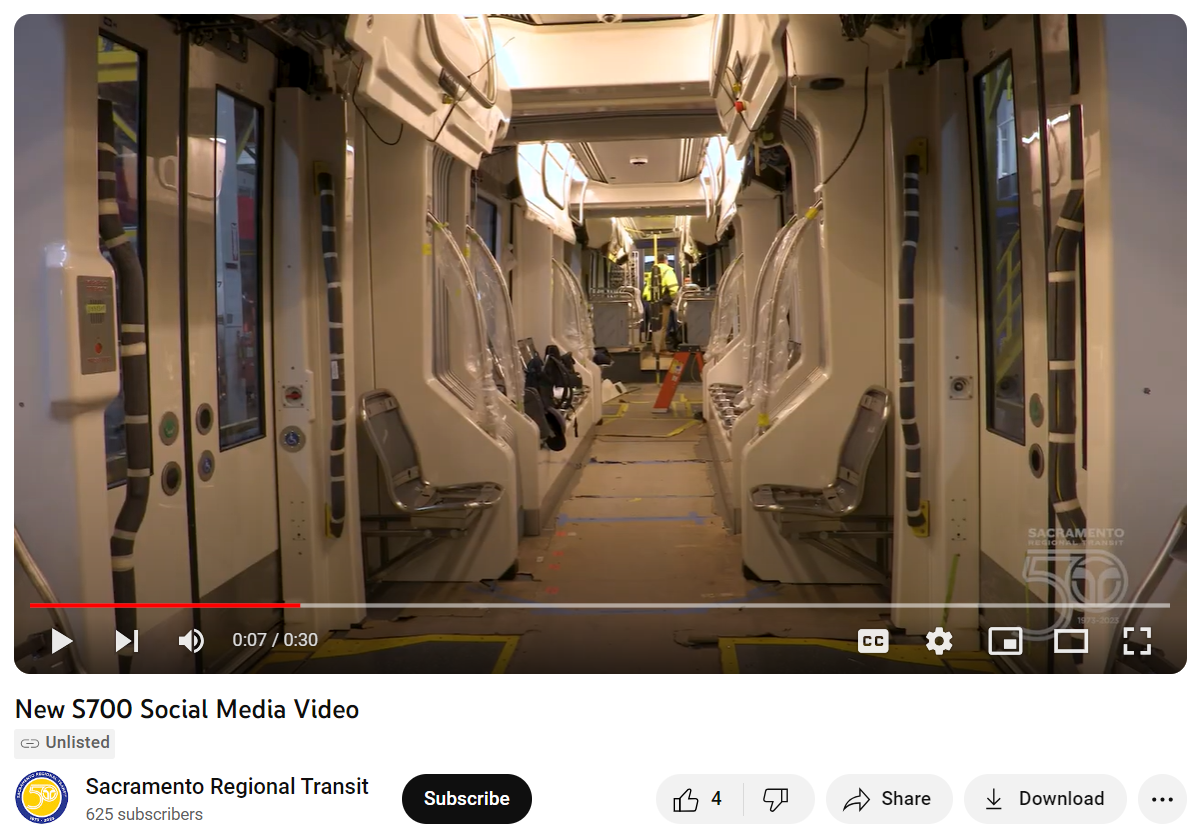Valley Transportation Authority: Groundbreaking Celebration for Transit-Oriented Affordable Housing 
VTA’s Transit-Oriented Development will add critical housing next to public transit. Local leaders, housing partners, and community members celebrated as developers broke ground on 135 affordable family-oriented apartments near VTA’s Tamien Light Rail Station on Oct. 18, 2023.
Tamien Station is a mixed-income housing community developed in partnership with the Santa Clara Valley Transportation Authority (VTA), The Core Companies, and Republic Urban Properties. The units feature one, two, and three-bedroom units affordable to households earning between 30%-60% of Area Median Income with 67 of those units allocated for rapid rehousing.
“VTA has a responsibility to contribute to the community’s wellbeing,” said Carolyn Gonot, VTA General Manager and CEO, “and we are proud to be part of the solution to Silicon Valley’s housing crisis.”
The 1.6-acre site was previously a parking lot owned by VTA. The property is being made available through a long-term lease to the Urban Co Tamien LLC which will bring in revenue to VTA to support transit service. The deal includes a requirement to provide affordable housing. In addition to supplying San Jose with 135 new affordable homes, the first phase of the project will also include a childcare center and an expanded transit plaza.
Funding for the project comes from a variety of sources including the California Debt Limit Allocation Committee, Santa Clara County’s voter-approved Measure A, the City of San Jose, and Affordable Housing and Sustainable Communities.
The Tamien development is among seven projects VTA has in the pipeline to create mixed-use, mixed-income neighborhoods connected by transit that better support pedestrians and bicycling. Others include a property next to the Berryessa Transit Center, which houses the BART station, Blossom Hill Station, Capitol Station, Branham Station, Winchester Station, and the prior Evelyn Station Park and Ride lot. The VTA Board increased its Affordable Housing Policy goals to ensure that 40% of its residential Transit Oriented Development portfolio will be developed as affordable units (up from 35% previously.) In addition, the affordable set-aside in each market-rate project was increased from 20% to 25%.
LA Metro Surpasses 900k Daily Riders in September, Achieves Highest Daily Ridership Since Pandemic
The Los Angeles County Metropolitan Transportation Authority (Metro) announced that the agency saw a 10 percent year-over-year increase in total system ridership in September 2023 compared to September 2022 with more than 24.5 million boardings, marking the 10th consecutive month of year-over-year ridership growth. Metro’s monthly bus and rail ridership is now at nearly 80 percent of its 2019 pre-pandemic level. Average weekend ridership is now at 91 percent of pre-pandemic (September 2019) levels and 77 percent for average weekdays. The increased focus on safety, and the resulting 53 percent decrease in crime across the system since April, is helping to drive increased ridership, along with improved reliability and frequency of service.
In September, Metro had 24,671,730 boardings on its bus and rail services. An average of 938,167 rides were taken each weekday, the first time since February 2020 that weekday Metro ridership has surpassed 900,000 boardings. Saturday boardings averaged 637,957 and Sunday boardings averaged 543,721. Post-pandemic ridership recovery continues to be strongest on the weekends, with average boardings on Saturdays reaching 86 percent of their (September 2019) pre-pandemic level and average boardings on Sundays reaching 92 percent of their (September 2019) pre-pandemic level.
In September 2023, Metro bus ridership saw an 11 percent year-over-year increase. More than 19.5 million rides were taken on Metro buses, with total bus ridership in September 2023 at 81 percent of its level in September 2019, before the pandemic. Average weekday bus ridership increased by 50,000 riders in September 2023 over August 2023, with more than 750,000 average weekday riders.
In its third year, Metro’s GoPass pilot program, which offers free transit passes to K-12 and community college students in participating schools, had over 1.6 million student boardings in September 2023, a 23 percent year-over-year increase over September 2022, which saw 1.3 million boardings. In September 2023 GoPass boardings were 103 percent higher than August 2023 which saw 801,163 student boardings. The program observed 1,458,992 student bus boardings and 164,806 student rail boardings during September 2023. To date the program has 345,907 registered students from 1,537 participating schools in 110 participating school districts (including public districts, charter networks, community college and private schools). Since the program launched in October 2021, there have been more than 25 million boardings by students using the free fare student GoPass.
Metro also provides accessible and affordable transit through its reduced-price transit pass program LIFE. Metro’s Low-Income Fare is Easy (LIFE) program gives free rides and reduced fares to low-income customers. Those new to the program receive a free 90-day pass. After the first 90 days, riders can either load 20 free rides or purchase a discounted pass from any of the LIFE participating transit agencies. The LIFE program helps qualifying Los Angeles County residents save money by providing free rides or deeply discounted fares on 13 transit systems across Los Angeles County.
BART participates in Great California ShakeOut 2023
BART participated in the Great California ShakeOut earthquake drill Thursday, October 19, 2023 to test our emergency response systems and to help raise public awareness of the importance of having a plan and being prepared.
At 10:19 am, BART staff triggered its ShakeAlert early warning earthquake system to ensure it is functioning and working correctly. Once triggered, trains automatically slow down to 27 mph. Then all trains come to a very brief stop. BART also made a systemwide public announcement encouraging riders to be prepared for earthquakes. BART also tested our internal communications systems to notify employees and the Operations Control Center observed earthquake alarms and our train control systems to ensure they are working properly.
BART is an early adopter of the ShakeAlert system which is connected to seismic stations located throughout Northern California. When the alarm is triggered, the system sends a speed restriction command to trains. This system removes human response time and can even slow trains down before the shaking occurs depending on how far away the quake is centered.
For the first time in recent years, BART is adding simulated damage inspections to its ShakeAlert drill. Shortly after the ShakeAlert was triggered, about 60 engineers divided into teams and fanned out to all 50 stations to conduct structural assessments. The engineers inspected walkways, support structures, elevators, escalators – anything that could sustain damage in a powerful earthquake. The simulation is designed to identify areas for improvement and to exercise “muscle memory” for BART’s earthquake response.
Santa Cruz METRO Applauds “Green” Benefits from California’s Regional Hydrogen Hub U.S. Department of Energy (DOE)
The Santa Cruz Metropolitan Transit District (METRO) celebrateed the selection of the Alliance for Renewable Clean Hydrogen Energy Systems (ARCHES), a statewide hydrogen hub initiative in California, as a key recipient of funding from the DOE’s Regional Clean Hydrogen Hubs program. Last week, the DOE announced that ARCHES has been awarded $1.2 billion. As part of the ARCHES team, METRO, and the Center for Transportation and the Environment (CTE) aim to deploy “green” hydrogen-powered, fuel-cell electric buses (FCEBs) in Santa Cruz County.
“METRO is proud to be a partner of ARCHES and play a role in its success,” said METRO Board Chair, Shebreh Kalantari-Johnson. “This program will help Santa Cruz County, California, and the nation grow the clean energy economy and transition to a zero-emissions transportation sector.”
ARCHES’ intention is to only fund the production and use of “green” hydrogen that has been produced with renewable resources and that meet or exceed federal carbon intensity requirements on a life cycle emission basis. All electrolytic hydrogen projects that receive funding support will have to meet ARCHES criteria. Proposals will be evaluated based on ARCHES vetting criteria and overall GHG, local air quality, state environmental goals, and community impacts. ARCHES will use mechanisms that are recognized by state and federal authorities to track that electricity used to produce hydrogen is renewable and to evaluate hub carbon intensity.
“METRO has set an aggressive goal to be 100% emissions-free by 2037,” said METRO Board Vice Chair, Kristen Brown. “The selection of ARCHES as a Hydrogen Hub by the DOE may greatly assist in our efforts to meet the state of California’s clean energy mandates ahead of schedule.”
SacRT Orders Eight Additional Siemens Mobility S700 LRVs 
The Sacramento Regional Transit District (SacRT), the largest transit agency in the Sacramento region of California, is strengthening its fleet with an order of eight additional S700 low floor light rail vehicles (LRVs) from Siemens Mobility. This order builds upon the initial purchase of 20 Siemens Mobility S700 LRVs in 2020, followed by the additional order of eight more in 2021, bringing the total number of vehicles on order by SacRT to 36.
“SacRT’s order of eight additional S700 LRVs is a testament to our shared dedication to providing trains that elevate the passenger experience, promote long-term sustainability, and enhance operational availability,” said Michael Cahill, President of Siemens Mobility in North America. “These trains will share a close connection with the region they serve, as they will be locally manufactured at our Siemens Mobility facility in Sacramento, continuing to enhance the long legacy of building light rail vehicles in Florin Park. We are excited to help make our hometown of Sacramento more accessible and connected and are grateful to SacRT for their continued partnership in this exciting endeavor.”
“These state-of-the-art trains not only signify our commitment to providing efficient and modern mobility solutions but also reflect our dedication to serving the community equitably,” said SacRT General Manger/CEO Henry Li. “This investment will not only improve the quality of travel for our passengers but also contribute to a more sustainable future for the Sacramento region.”
“The additional order of new light rail cars builds upon SacRT’s strong relationship with Siemens here in Sacramento and will dramatically improve accessibility and comfort for our riders,” said SacRT Board Chair and Sacramento County Supervisor Patrick Kennedy. “We are accelerating SacRT’s light rail modernization program which will improve the reliability of our fleet and improve access for persons with disabilities, seniors, bicyclists and families with strollers.”
The S700 low-floor LRVs will have low-level boarding at every doorway, a spacious seating design, larger windows for better light and views and improved accessibility with wider aisles. In addition, the vehicles have improved performance and optimized availability provided by condition monitoring, remote diagnostics, and predictive maintenance.
The S700 LRV’s for SacRT are proudly manufactured in Sacramento, California. This plant stands as one of the largest and most sustainable facilities of its kind in the U.S., harnessing the power of the California sun through its 2.1 MWp solar panel installation. It is part of Siemens Mobility’s larger U.S. manufacturing network of eight facilities, nearly 4,500 employees and 2,000 suppliers.